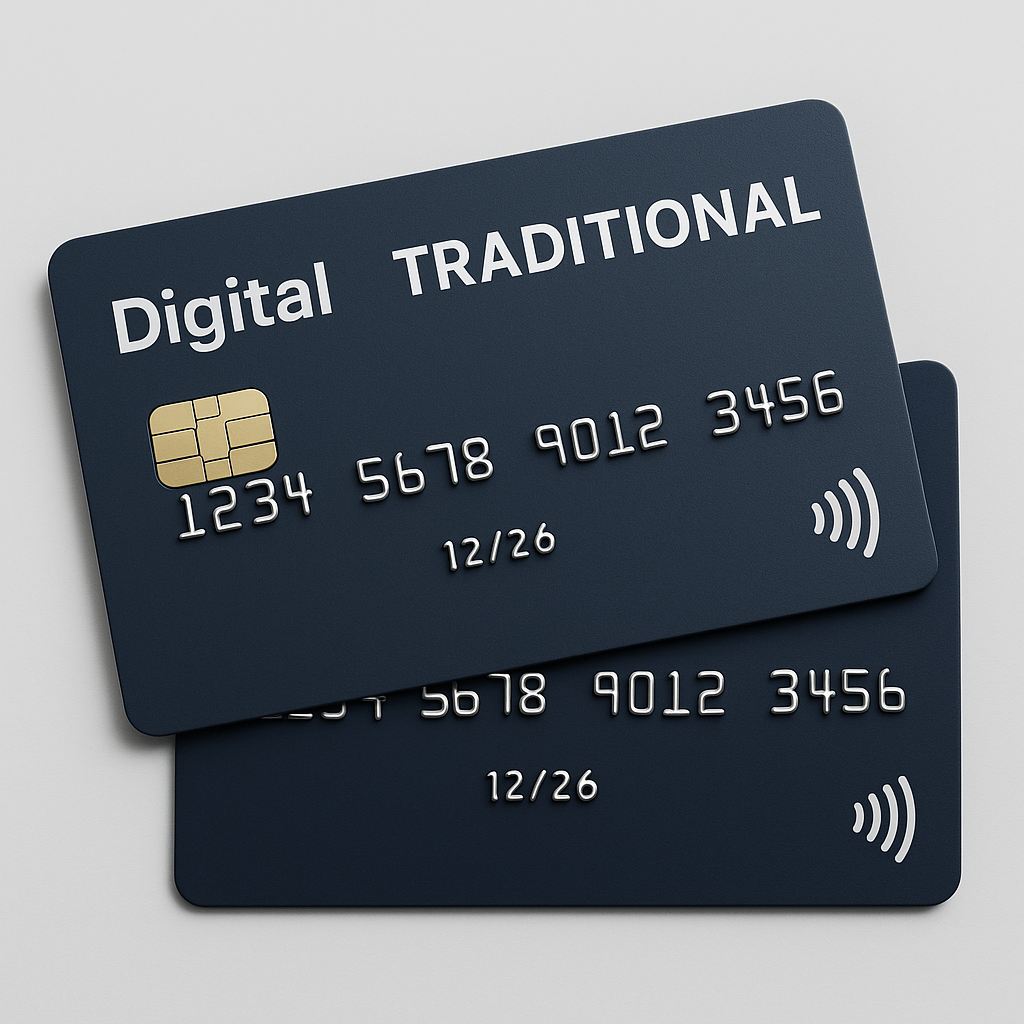As the financial world evolves rapidly, the way we use credit cards is also changing. In 2025, consumers can choose between digital credit cards and traditional physical cards—but how do you know which one is right for you?

In this guide, we’ll compare both types, highlight the pros and cons, and help you decide which option aligns best with your financial habits and lifestyle.
What Are Digital Credit Cards?
A digital credit card exists entirely online. Issued by digital-first banks or fintech platforms, these cards are accessible through a mobile app or browser. They come with:
- A virtual card number
- Expiry date and CVV
- Real-time notifications
- Integration with digital wallets (Apple Pay, Google Pay)
Most digital cards also offer physical versions, but the core experience is online.
What Are Traditional Credit Cards?
A traditional credit card is issued by brick-and-mortar or long-established banks. It comes with a physical card that you can swipe, tap, or insert in stores. Most are now supported by mobile apps, but the focus is still on the physical product and legacy services.
Key Differences Between Digital and Traditional Cards
| Feature | Digital Cards | Traditional Cards |
|---|---|---|
| Card Type | Virtual (optional physical) | Physical (optional digital) |
| Issuers | Fintechs, digital banks | Traditional banks, credit unions |
| Onboarding | 100% online | Online or in-person |
| Approval Speed | Instant or same-day | 1–7 business days |
| Foreign Fees | Often none | Sometimes present |
| Rewards | Growing selection | Broad variety |
| Security | Real-time controls via app | Traditional + some app options |
Advantages of Digital Credit Cards
1. Instant Issuance
Apply and get approved within minutes—no need to wait for a physical card in the mail.
2. Enhanced Security
Many digital cards offer disposable numbers, instant freeze/unfreeze, and detailed transaction tracking.
3. Global Accessibility
Ideal for remote workers, freelancers, and digital nomads who want to manage finances across borders.
4. Low Fees
Digital banks often waive annual fees, foreign transaction fees, and ATM charges (within limits).
5. User-Friendly Apps
Track spending, set budgets, and control settings all from your smartphone.
Advantages of Traditional Credit Cards
1. Wider Acceptance
Accepted everywhere, even where contactless or virtual payments aren’t supported.
2. Comprehensive Rewards
Established banks offer robust rewards programs for travel, dining, cashback, and more.
3. Credit-Building Power
Many traditional issuers report to all credit bureaus, aiding long-term credit growth.
4. Premium Perks
Travel insurance, airport lounge access, concierge services—often exclusive to legacy cards.
5. Customer Service
Phone and in-person support are still superior with traditional banks.
Best Digital Credit Cards in 2025
- Revolut Metal – Real exchange rates, global access, and concierge.
- Wise Debit Card – Ideal for currency exchange and international payments.
- N26 You – Includes travel insurance, real-time notifications, and zero foreign fees.
- Monzo – Great budgeting features and free ATM withdrawals abroad (limits apply).
Best Traditional Credit Cards in 2025
- Chase Sapphire Preferred – Excellent for travel, points, and flexibility.
- Amex Platinum – Premium perks, lounge access, 5x points on travel.
- Capital One Venture Rewards – Flat-rate travel miles and no foreign fees.
- Citi Double Cash – 2% cashback on all purchases, no annual fee.
Which Card Should You Choose?
Choose Digital Cards If You:
- Prefer mobile-first experiences
- Travel often or work remotely
- Want low fees and flexible features
- Use contactless and online payments frequently
Choose Traditional Cards If You:
- Want premium rewards or travel perks
- Need help building credit with a major issuer
- Prefer a physical card for everyday use
- Value in-person customer support
Can You Use Both?
Absolutely. Many savvy consumers combine both types:
- Use a digital card for everyday and international purchases.
- Use a traditional card for rewards, credit building, and major purchases.
This strategy helps maximize rewards, manage fees, and increase flexibility.
Final Thoughts
In 2025, the decision between digital vs traditional credit cards depends on how you spend, travel, and manage money. Digital cards offer speed, savings, and security. Traditional cards offer rewards, reliability, and global reach.
You don’t have to choose just one. Instead, build a wallet that reflects your lifestyle—and get the best of both worlds.
